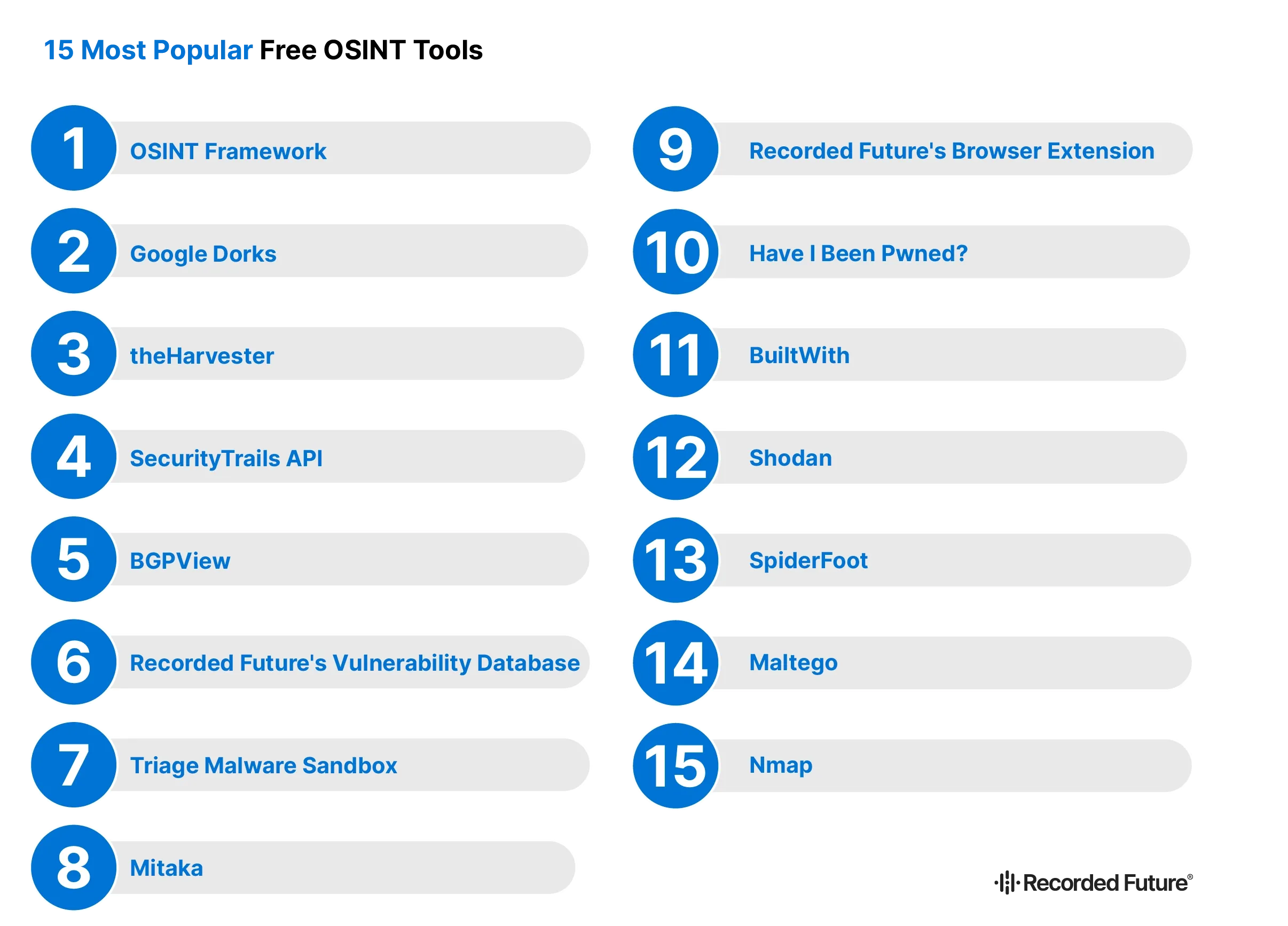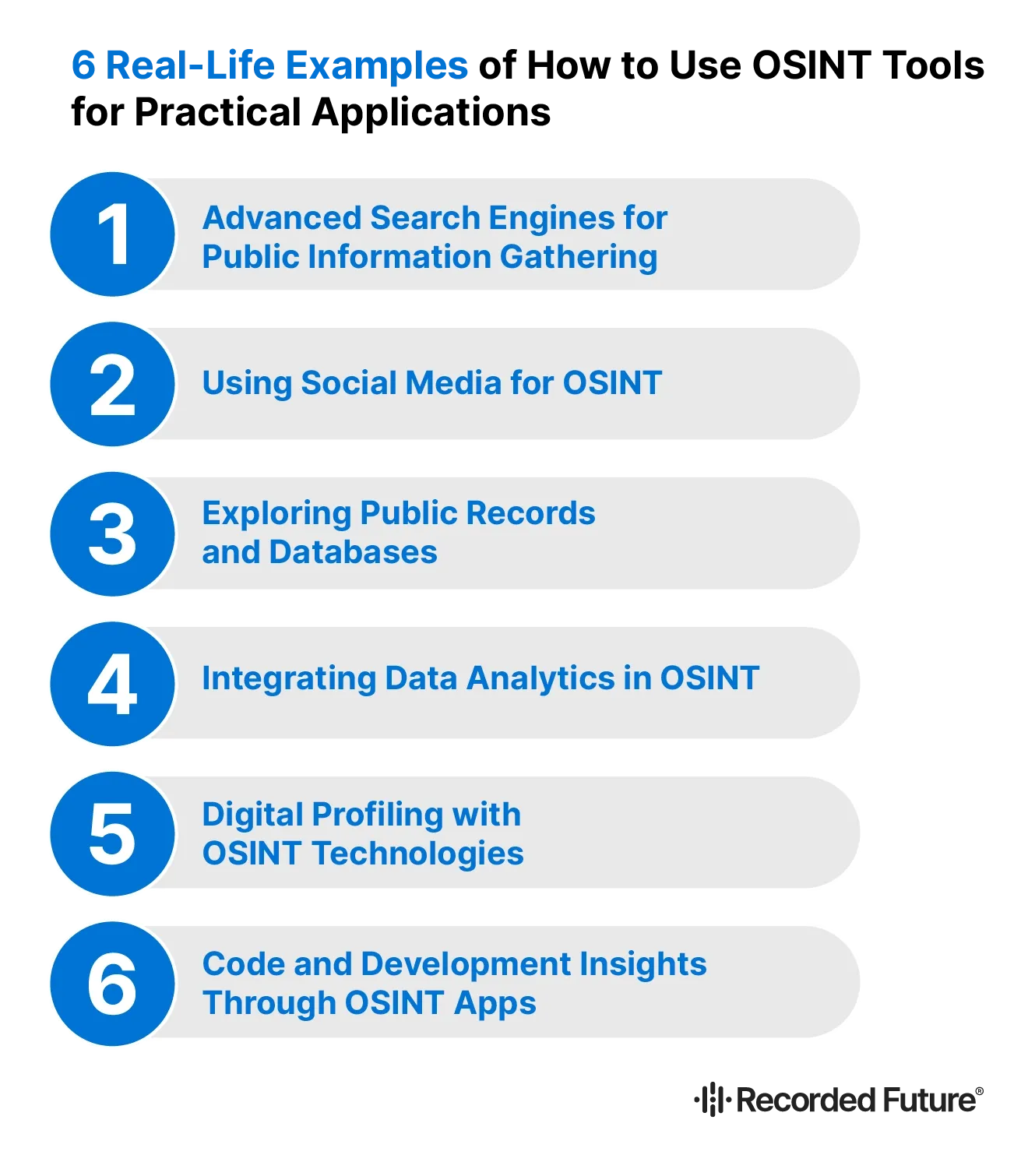Top 15 OSINT Tools for Expert Intelligence Gathering
OSINT Tools are a key part of any information gathering process, especially when it comes to understanding and reducing your attack surface in cybersecurity intelligence. Reflecting their importance, the global open source intelligence market, valued at $5.02 billion in 2018, is expected to grow to $29.19 billion by 2026, with a CAGR of 24.7% from 2020 to 2026.
This article covers the role of OSINT tools, a brief history, and how to use these popular tools to deliver crucial intelligence insights.
Key Takeaways
- OSINT (Open Source Intelligence) tools allow for the efficient gathering and analysis of publicly available data, which is used by government agencies and private organizations to analyze market trends, brand positioning, and more. These tools have advanced from traditional media to incorporate technologies like web scraping, social media analytics, geospatial intelligence, and AI to improve precision and speed in data processing.
- Advanced search engines and specialized services such as The Internet Archive, and browser extensions like Mitaka, along with Google advanced search operators known as Google dorks, are critical in exploring the web for OSINT purposes. They enable efficient navigation and analysis of content not indexed by standard search engine practices.
- OSINT practices must comply with legal standards such as Europe’s GDPR to ensure responsible intelligence collection. This involves a focus on ethical considerations, understanding the legal framework, and utilizing OSINT tools such as public records search engines, social media monitoring, and network scanning tools, while maintaining transparency and avoiding unauthorized data access.
About Open Source Intelligence
Open Source Intelligence (OSINT) is:
- The art and science of gathering information from publicly available sources
- Turning raw data into actionable insights
- In high demand as the digital universe expands
- Used by government agencies and commercial organizations alike for reconnaissance, enhanced cyber crime investigations, and more
- Provides valuable insights about market trends and brand positioning.
OSINT operates on a wide range of OSINT data sources, including public data from various OSINT techniques such as:
- broadcast TV
- radio
- social media
- websites
OSINT is a powerful resource for collecting data in various formats such as text, video, image, and audio. The incorporation of advanced technologies like machine learning and neural networks allows for the recognition of trends and patterns, and the identification of crucial elements like individuals or topics through the analysis of various data sources.
Evolution of OSINT Tools
OSINT tools have evolved significantly over time. Initially focused on traditional media analysis such as newspapers and radio, OSINT tools have shifted towards harnessing the vast information resources available on the internet, in both private and public sectors. Modern OSINT tools have moved beyond simple search engines, now incorporating complex analytical and visualization capabilities.
Incorporating state-of-the-art technologies like web scraping, social media analytics, and geospatial intelligence, these platforms have revolutionized the way information is extracted and evaluated.
The future of OSINT tools is expected to be driven by artificial intelligence and machine learning, offering enhanced precision and speed in data processing and analysis.
Top OSINT tools come equipped with features that enhance the intelligence gathering process. One of these features is built-in data transformations, which allow for the conversion of retrieved information into more useful or readable formats. To tailor data collection and analysis to specific user needs, several OSINT tools enable custom transformations.
Unlock the power of intelligence with Recorded Future University! Access our Free Intelligence Fundamentals Course to become a certified analyst. Start transforming data into actionable insights today and proudly display your credentials on LinkedIn.
15 Most Popular Free OSINT Tools
There are numerous free OSINT tools that individuals and organizations can start using today. These tools cover a wide range of capabilities and can be used for various intelligence gathering purposes.

1. OSINT Framework: the OSINT Framework is a crucial web-based tool for researchers, organizing open source intelligence resources by source, type, and context. It is widely used across sectors including government, law enforcement, and corporate security to meet diverse data gathering needs. Community contributions continuously enhance the framework, while its operation adheres to legal standards like GDPR to ensure ethical data collection.
2. Google Dorks: Google Dorks, in use since 2002, offer specialized queries that harness Google's vast indexing to aid in security investigations. These queries can locate specific file types, extensions, text within pages, titles, and URLs—tools invaluable for exploring details about individuals and companies. Despite search engines typically not indexing sensitive data like log files, Google Dorks can still unearth such information, providing a critical resource for IT security.
3. theHarvester: included in the Kali Linux distribution, is a comprehensive tool used to gather information about subdomains, virtual hosts, open ports, and email addresses related to any company or website. theHarvester utilizes sources such as PGP key servers, search engines like Google and Bing, and social networks like LinkedIn to collect data, supporting both passive reconnaissance and active penetration tests. This tool is particularly useful for the initial stages of penetration testing on both local and third-party authorized networks.
4. SecurityTrails API: the SecurityTrails API allows you instant access to current DNS server records and historical records (known as DNS history), domain details, and associated domains, IP information, as well as WHOIS data so you can integrate it within your own applications for asset discovery, threat intelligence, risk scoring, and much more. The best part is that you only need an HTTP request to retrieve the data.
5. BGPView: effortlessly track BGP routing information and IP address data with BGPView, simplifying network monitoring tasks. Analyze network configurations, identify security threats, and monitor routing changes seamlessly. This intuitive network tool offers comprehensive insights accessible directly from your browser, enabling informed decisions to optimize network performance, identify threat actor origin, and much more.
6. Recorded Future's Vulnerability Database: access detailed vulnerability information from this free CVE DB. This tool provides invaluable insights for security teams to stay ahead of emerging CVEs. It includes useful information such as CVSS score, Attack Complexity level, Availability, a summary of each CVE, along with affected products and mitigation resources.
7. Triage Malware Sandbox: Explore malware samples for free with one of the most advanced and popular malware analysis sandboxes. This platform offers a customizable environment where you can submit high volumes of malware samples, enabling detection and extraction of configurations for a wide range of malware families.
8. Mitaka: this is an OSINT browser extension that can help you boost your daily operations, offering intuitive access to diverse intelligence-gathering features for efficient reconnaissance and investigative tasks. Developed with a user-centric approach, Mitaka seamlessly integrates multiple OSINT modules, enabling comprehensive analysis of target entities.
9. Recorded Future's Browser Extension: easily access intelligence data from any web-based resource with this threat intelligence browser extension, streamlining security operations. This OSINT extension will help you investigate phishing emails, detect IOCs, prioritize vulnerability patching, and expedite alert processing within your SIEM.
10. Have I Been Pwned? HaveIbeenPwned can help you to check if your account has been compromised in the past. This site was developed by Troy Hunt, one of the most respected IT security professionals of this market, and it's been serving accurate reports for years. If you suspect your account has been compromised, or want to verify for 3rd party compromises on external accounts, this is the perfect tool. It can track down web compromises from many sources like Gmail, Hotmail, Yahoo accounts, as well as LastFM, Kickstarter, Wordpress .com, Linkedin and many other popular websites.
11. BuiltWith: serves as a comprehensive profiler for identifying the various technologies deployed on websites, from server frameworks to analytics and content management systems. It delivers in-depth analysis of web setups, crucial for competitive intelligence and technology strategy development. This tool is vital for those seeking insights into the tech infrastructure of digital platforms.
12. Shodan: conceived by John Matherly in 2009, serves as a network security monitor and specialized search engine for the deep web and IoT. It enables users to explore a plethora of network-connected devices, organizing results by country, operating system, and network type, providing invaluable insights for IT security researchers.
13. SpiderFoot: developed by Steve Micallef, stands out as a top reconnaissance tool for automating OSINT with swift results in reconnaissance, threat intelligence, and perimeter monitoring. It harnesses over 100 public data sources to gather intelligence on various targets, including generic names, domain names, email addresses, and IP addresses, simplifying the process through easy-to-use module selection and target specification.
14. Maltego: developed by Paterva and featured in the Kali Linux distribution, is a robust tool designed for detailed digital reconnaissance of targets. It utilizes "transforms" to integrate and analyze data from external applications, available in both free and commercial versions. Users can launch investigations to obtain comprehensive results, such as IPs, domains, and AS numbers, through Maltego's platform.
15. Nmap: while some network scanners may not be technically considered OSINT tools, they are widely integrated into many of these platforms. The information gathered by network scanners is usually accessible through public channels, aligning with the principles of Open Source Intelligence (OSINT). One of the best examples is the formidable Nmap. This network and port scanner is an excellent tool for intelligence gathering, offering literally dozens of Nmap commands to perform reconnaissance processes from both the terminal and GUI.
6 Real-Life Examples of How to Use OSINT Tools for Practical Applications

Advanced Search Engines for Public Information Gathering
Advanced search engines play a critical role in navigating and analyzing deep web content that is not indexed by conventional search engines but remains publicly accessible. Services like Intelligence X serve as both archival and search platforms, providing access to historical web pages and datasets that have been removed from the internet. The Internet Archive, Babel X, and AttackerDB, on the other hand, facilitates the exploration of threat actors and intelligence data over public internet sources, including the dark web and deep web content via agreements with content owners.
Region-specific and privacy-focused search engines offer crucial tools in OSINT for delivering localized information and conducting searches independently from typical search engines.
Information gathering through tools like Mitaka, an OSINT browser extension, enhances search capabilities within web browsers, enabling users to perform searches across a variety of search engines for different digital indicators directly within the web browser environment.
Advanced Google Dorks for Deeper Insights
Advanced search operators, known as Google dorks, can be used to extract deeper insights from Google. These operators are not standard search terms, but specific commands that direct Google to search in a particular way. Automated tools such as Dork Search, Advangle, and DorkGenius are designed to simplify the creation and suggestion of these advanced search operators.
These tools allow users to search for specific types of information, such as files of a certain format, pages that link to a particular website, or pages on a site that contain specific keywords. Google dorks can be used by researchers to uncover hard-to-find information, by security professionals to identify vulnerabilities, and by malicious actors to uncover sensitive information.
Specialized Dark Web OSINT Services
Navigating the dark web, a part of the internet that isn’t indexed by standard search engines, can be daunting. However, dark web search services have made this process more accessible. These search engines can be used without specialized browsers, allowing users to search dark web content safely, and are crucial for effective dark web monitoring, enabling users to scan a wide range of sources, including public internet venues and some dark web content.
Accessibility is a key feature of these services, providing free access to users. They can be used from standard web browsers and do not require the use of Tor or other specific software, making the search process more user-friendly.
As covered in our recent blog post Improving Dark Web Investigations with Threat Intelligence Recorded Future's Dark Web Intelligence elevates dark web OSINT by providing deep, actionable insights into hidden cyber activities. This enables organizations to detect and monitor advanced threats like stolen credentials and compromised systems efficiently.
Our service transforms manual OSINT practices by offering comprehensive audit of dark web forums, marketplaces, and encrypted chat services, thus alerting organizations to potential security breaches and data exposures that require immediate attention.
Using Social Media for OSINT
Social media platforms have become a goldmine for OSINT, providing a wealth of publicly available data that can be used for intelligence gathering. OSINT tools like Instant Data Scraper and TG-API facilitate the extraction of data from various social media accounts including Facebook, Instagram, Twitter, and Telegram.
These tools not only allow analysts to extract data but also to analyze it. Tools such as Paliscope YOSE enable analysts to analyze social media data by creating link charts and visualizing connections, supporting in-depth scrutiny of online behaviors and relationships through market research.
Both security personnel and threat actors utilize these tools - the former to detect inadvertent information sharing on social media channels, and the latter to exploit exposed data to learn how to defend against phishing attacks targeting company insiders.
Exploring Public Records and Databases
Public records and databases offer a treasure trove of information that can be tapped into for OSINT. These can include everything from property ownership and cybercriminal history to social media activities. Dedicated search engines are designed specifically for sifting through these public records, enabling efficient retrieval of current and historical information significant for OSINT practices.
The democratization of OSINT has been facilitated by the availability of cost-effective tools. These tools have made open-source intelligence collection more accessible for a wider range of enterprises and investigative experts, regardless of their size. This has broadened the scope and reach of OSINT, allowing more stakeholders to leverage its potential. Some of these cost-effective tools include:
- Social media monitoring platforms
- Web scraping tools
- Data visualization software
- Image and video analysis tools
Integrating Data Analytics in OSINT
Analytics play a pivotal role in shaping OSINT practices. The integration of big data analytics with artificial intelligence (AI) and machine learning enhances the accuracy and efficiency of intelligence analysis, supporting the generation of actionable intelligence. This allows for more informed decision-making based on the actionable insights derived from the data.
Advanced OSINT analytics tools offer several benefits, including:
- Automating processes to reduce human error and improve efficiency and speed for data processing
- Enabling faster identification of emerging threats and real-time monitoring
- Aiding in visualization and reporting by converting data into clear and concise visual representations
- Assisting in fact-checking and debunking images and videos through specialized extensions like InVID and WeVerify.
The use of the OSINT Framework and other analytical tools in real-time can provide insights into current events, incidents, and trends, enhancing the situational awareness necessary for informed decision-making.
Digital Profiling with OSINT Technologies
OSINT technologies enable the creation of extensive digital profiles of individuals or entities. These profiles are constructed by weaving together different public records using a variety of OSINT tools. Tools like Maltego assist in swift data gathering and visualization from a range of sources, while using ADINT enables tracking movements and identifiers across multiple ad platforms.
Strategic methods such as domain name searches are employed by investigators to acquire insights into an individual’s or entity’s online activities. These activities can be tracked through:
- Email addresses
- Phone numbers
- IP addresses
- MAC addresses
- Operating system identifiers
Code and Development Insights Through OSINT Apps
OSINT can provide valuable insights into code and development. Tools like grep.app, searchcode, and SourceGraph facilitate deep searches across multiple git repositories to locate strings, uncover code patterns, and assist in analyzing open source development projects.
Code search engines such as grep.app, NerdyData, and PublicWWW enable researchers, including those in academic research, to understand coding patterns, competitive market positions, and specific implementations that offer development insights.
FAQs
What is an open source intelligence tool?
An open source intelligence tool is used to gather publicly available information from social media, websites, and news articles to identify vulnerabilities and plan attacks.
How can social media be used for OSINT?
Social media can be used for OSINT by using tools like Instant Data Scraper and Paliscope YOSE to extract and analyze data from different social media platforms, offering insights into online behaviors and relationships.
How can legal compliance be ensured in OSINT practices?
To ensure legal compliance in OSINT practices, it's important to adhere to laws and regulations, be transparent in actions, and ensure the lawful and ethical collection of data. These steps are crucial for maintaining integrity and abiding by legal standards.
OSINT activities are subject to varying legal regulations globally, which can pose risks, especially with laws like Europe’s GDPR dictating strict data usage rules. In Germany, conducting OSINT requires a documented legitimate interest confirmed by legal counsel. Best practices recommend adhering to service terms, using pseudonyms cautiously, avoiding illegal data access, and ensuring transparency in operations.
Wrapping up
Today we've covered the evolution of OSINT tools and the construction of digital profiles, highlighting their value for learning, training, and legal compliance. By mastering these tools and techniques and adhering to legal standards, you can effectively extract valuable insights from publicly available data for both professional development and operational effectiveness.
Integrating OSINT with threat intelligence significantly enhances security by providing detailed insights into potential threats. Learn how to proactively identify and mitigate risks with the most advanced threat intelligence platform. Schedule a demo today.

Esteban is a seasoned security researcher and IT professional with over 20 years of experience, specializing in hardening systems and networks, leading blue team operations, and conducting thorough attack surface analysis to bolster cybersecurity defenses. He's also a skilled marketing expert, specializing in content strategy, technical SEO, and conversion rate optimization. His career includes roles as Security Researcher and Head of Marketing at SecurityTrails, before joining the team at Recorded Future.
Related News & Research



